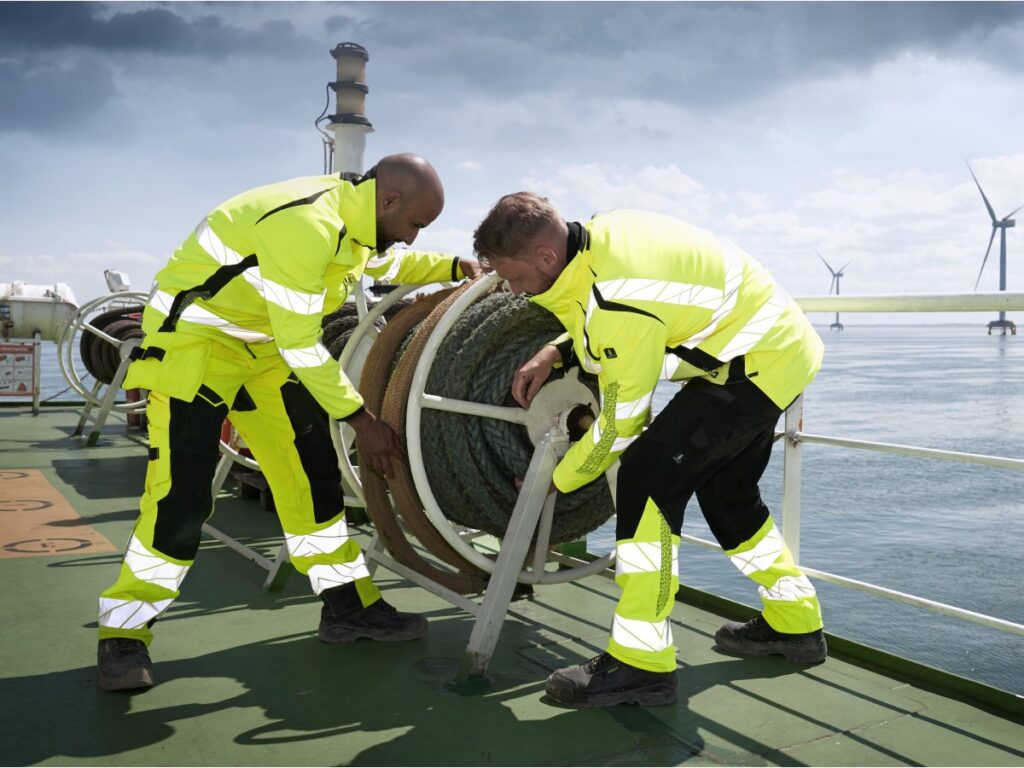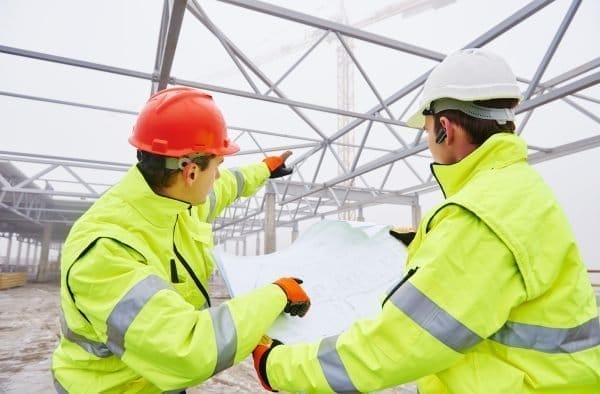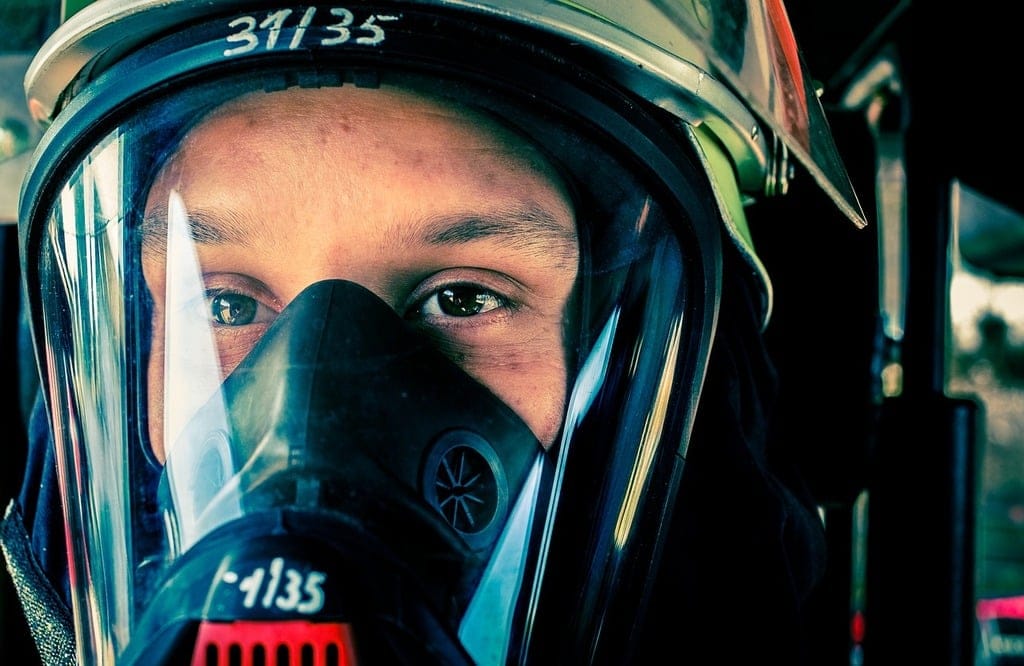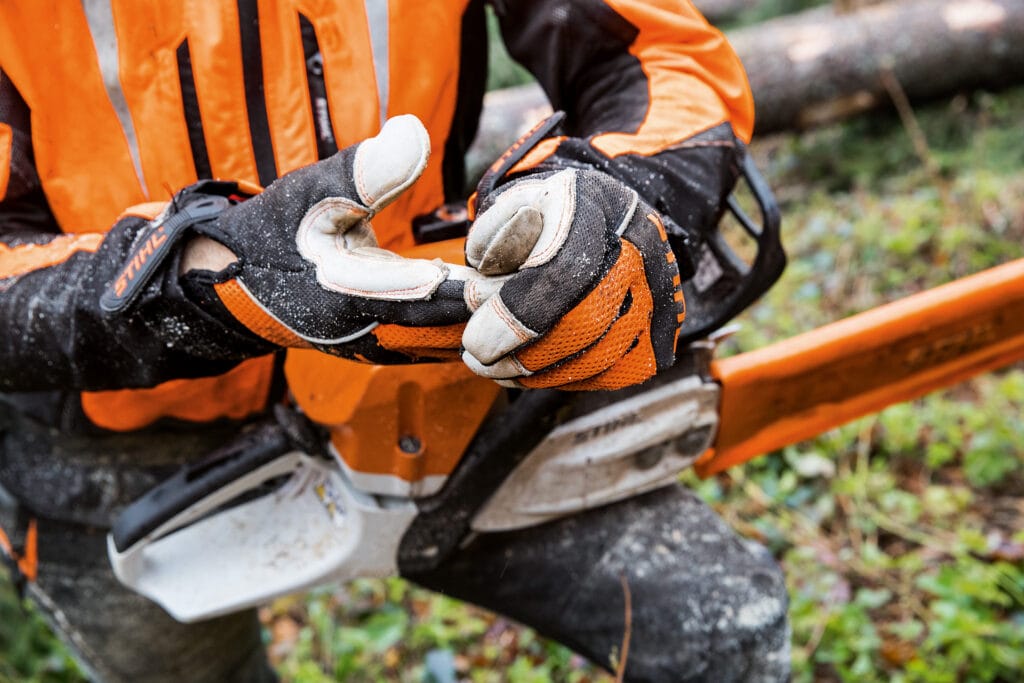
Walk through any African city today, and you’ll see construction everywhere. Tower cranes in Lagos, new highways in Nairobi, railways in Addis Ababa, housing projects in Accra, and power plants along the Nile. This is the face of Africa’s infrastructure boom. Behind these projects are millions of workers, and every one of them needs the right workwear to stay safe, comfortable, and productive.
Workwear here is not just fabric and stitches. It’s a safety net, a productivity tool, and a badge of professionalism. And for distributors, agents, and traders, it’s a growing market that—if you play it smart—can become a goldmine.
This guide dives deep into market size, demand trends, product must-haves, material choices, sourcing pitfalls, compliance issues, and real-life buyer stories from across Africa’s construction boom.
Africa’s construction boom drives massive demand for workwear like reflective vests, durable coveralls, safety boots, and helmets. Key markets include Nigeria, Kenya, Ethiopia, and South Africa. Buyers prioritize cost-effectiveness, comfort in hot climates, and compliance with international safety standards. The opportunity lies in offering affordable yet certified workwear that meets both local and international requirements.
Why Africa’s Construction Growth Creates Workwear Demand
Africa’s construction industry is one of the fastest growing in the world. Let’s break down why that matters for workwear.
-
Massive infrastructure projects
Governments and private investors are pouring billions into infrastructure. From Ethiopia’s Grand Renaissance Dam to Kenya’s Standard Gauge Railway, these mega-projects employ tens of thousands of workers. Each worker requires multiple sets of workwear per year due to wear, tear, and hygiene. -
Government investment & foreign funding
Initiatives like China’s Belt and Road, plus funding from the World Bank and African Development Bank, are fueling construction. Every new project comes with health and safety requirements—meaning certified workwear is a mandatory part of the procurement list. -
High accident rates
According to the ILO, construction is one of Africa’s most dangerous industries. Poor visibility, falling debris, heat stress, and unsafe equipment contribute to accidents. Workwear such as reflective vests, helmets, gloves, and boots can significantly reduce risk. Companies that ignore this often face lawsuits, project delays, or worker strikes. -
Hot and diverse climates
Africa’s climate is unique: scorching deserts in the north, humid tropics in the west, and cooler highlands in the east. Standard European-style heavy cotton coveralls simply don’t work here. Workers need lightweight, breathable fabrics that still provide durability. This creates a niche for specially adapted workwear. -
Rising middle class and professionalism
Beyond safety, workwear is becoming a symbol of professionalism. Contractors competing for international projects need their workers to look uniform and well-equipped. A properly dressed team wins trust from investors, auditors, and local communities.
Real-World Cases from African Construction Sites
Let’s look at real incidents that highlight the critical role of workwear.
Case #1 – Highway Project in Kenya
In 2022, workers paving a new Nairobi-Mombasa expressway were given heavy 100% cotton overalls. Temperatures soared to 34°C, and within weeks, multiple workers reported heat exhaustion. Productivity dropped.
Fix: The contractor switched to polyester-cotton blend overalls with reflective stripes. The lighter fabric improved comfort, and reflective details enhanced visibility during night shifts. Output per worker increased by 15%.
Case #2 – Cement Plant in Nigeria
A distributor supplied a batch of low-cost PVC safety boots to a cement factory in Ogun State. Within three months, the boots cracked due to constant contact with cement dust and alkaline water. Replacements cost the company both time and money.
Solution: After testing, they upgraded to nitrile-PVC blended boots with reinforced soles. The lifespan doubled, reducing replacement frequency and cutting annual boot expenses by nearly 40%.
Case #3 – Rail Project in Ethiopia
During night operations on a railway project, workers without high-visibility vests had multiple near-misses with heavy machinery. One accident nearly caused a fatality.
Outcome: Reflective safety vests were made mandatory, especially for night shifts. After implementation, accident rates dropped, and international inspectors praised the project’s improved safety record.
Case #4 – Housing Project in Ghana
Workers were using local fabric hats instead of helmets. During roof installation, a worker suffered a head injury from falling debris. The cost of treatment and work stoppage exceeded $20,000.
Lesson: Even in smaller housing projects, helmets are essential. The contractor now requires every worker to wear HDPE helmets sourced from an international supplier.
Case #5 – Bridge Construction in Tanzania
A distributor tried supplying thick leather gloves for rebar workers. Workers refused to wear them because they were too stiff in the hot climate. Instead, many worked barehanded, leading to cuts and infections.
Adjustment: The distributor replaced them with lightweight nitrile-coated gloves, which provided grip and protection while remaining flexible and breathable. Adoption rate jumped to nearly 100%.
These stories show that wrong workwear is not just uncomfortable—it can kill projects. On the other hand, the right product builds trust, saves money, and locks in repeat orders from contractors.
Workwear Standards Relevant to African Projects
In construction, standards aren’t just paperwork—they’re protection. For African projects, compliance often depends on who funds the project (local government, Chinese contractors, European investors, or World Bank). Each brings its own set of rules.
| Standard / Regulation | Purpose | Where It Applies in Africa |
|---|---|---|
| EN ISO 13688 | General requirements for protective clothing | Widely required on EU-funded projects |
| EN ISO 20471 | High-visibility clothing (reflective vests, jackets) | Common in road, airport, and port projects |
| ANSI/ISEA 107 | US standard for reflective safety wear | Projects funded by American contractors (oil & gas) |
| SANS Standards (South Africa) | Local South African safety compliance | Mandatory in South Africa-based projects |
| Company-specific standards | Multinationals like Shell, Total, or Sinohydro may demand extra compliance | Oil & gas, mega infrastructure |
🔑 Why it matters:
- A Kenyan contractor building a World Bank-financed road must follow EN ISO 20471.
- A Nigerian oil project funded by Chevron may require ANSI standards.
- South African mining projects often demand SANS certification.
💡 Smart distributors often stock products with dual compliance (EN + ANSI) to cover more projects without carrying too much inventory.
Key Workwear Items for Africa’s Construction Boom
Let’s break down the essentials. These are not “optional”—they are the core of every project order.
| Item | Purpose | Recommended Material | Notes for Africa |
|---|---|---|---|
| Reflective Vests | Worker visibility in day & night projects | Polyester mesh with reflective tape | Must resist fading from sun exposure |
| Durable Overalls | Protection from dust, cement, abrasions | 65/35 poly-cotton blend | Lightweight for hot climates |
| Safety Boots | Foot protection on uneven, muddy sites | PVC/nitrile with steel toe | Choose oil & slip-resistant soles |
| Helmets | Head protection in active construction zones | HDPE or ABS plastic | Include sweatbands for comfort |
| Gloves | Grip & hand safety | Nitrile-coated cotton or leather | Use lighter gloves for rebar, heavier for cement |
| High-Vis Jackets (optional) | Night or rainy season visibility | PU-coated polyester | Needed in ports, rainy equatorial zones |
📌 Distributor tip: In Africa, reflective vests and boots sell in the highest volumes. They are the “entry products” for new distributors.
Material Selection Tips for Hot & Harsh Climates
Choosing the wrong material = complaints, returns, and lost credibility. Let’s unpack the best choices:
Overalls
- Poly-cotton (65/35 blend) → Strong, breathable, and affordable. Best for general construction.
- 100% cotton → Comfortable but shrinks easily and absorbs sweat. Not ideal for humid zones.
- Polyester-rich fabrics → Longer lifespan, but can be hot in direct sunlight.
Reflective Vests
- Polyester mesh → Lightweight, quick-dry, perfect for road projects in hot weather.
- Solid polyester fabric → More durable, but hotter. Good for ports and airports.
Boots
- PVC/Nitrile blend → Resistant to water, mud, cement, and some chemicals. Standard for construction.
- Leather boots → Durable but expensive. Not ideal for wet environments unless treated.
- Rubber boots → Affordable, but cheap versions crack quickly under African sun.
Helmets
- HDPE helmets → Lightweight, good for general use.
- ABS helmets → Stronger, often used in oil & gas, slightly more expensive.
✅ Pro Tip: Always test a small batch on-site before bulk shipping. Workers’ feedback often reveals issues you won’t see in a catalog.
Procurement Mistakes to Avoid
Many African distributors learn the hard way. Here are the top mistakes:
-
Going for the cheapest reflective vests
- Problem: Colors fade in 2–3 months, reflective strips peel.
- Impact: Contractors reject them, leaving you with unsold stock.
- Fix: Choose vests with UV-resistant dye and EN ISO 20471-certified tape.
-
Ordering boots unsuited to climate
- Example: A Ghana distributor imported winter-style leather boots. Workers refused to wear them in 35°C heat.
- Lesson: Match products to climate. Use lighter PVC/nitrile boots in hot, wet zones.
-
Ignoring certifications
- Without visible CE/ANSI marks, customs or contractors may reject the shipment.
- Always request certificates + sample labels before confirming production.
-
Skipping trial batches
- A Tanzanian distributor once ordered 10,000 overalls without testing. The fabric shrank badly after first wash. Half the order was wasted.
- Solution: Start with 200–500 sets, test, then scale.
-
No inspection before shipping
- Some suppliers cut corners—thinner fabric, poor stitching, weaker soles.
- Always do third-party inspection before shipment.
Cost-Benefit Analysis for African Buyers
Many new buyers only look at upfront cost. But real profit comes from lifetime savings. Let’s compare:
| Scenario | Without Correct Workwear | With Correct Workwear | Annual Impact |
|---|---|---|---|
| Heat stress sick leave (Kenya) | $15,000+ lost productivity per project | $3,000 spent on breathable overalls | Saves $12,000 |
| Injuries from poor visibility | $50,000 in accident/insurance costs | $2,500 on reflective vests | Saves $47,500 |
| Low-quality boot replacements | $20,000 spent yearly on re-orders | $8,000 on durable nitrile boots | Saves $12,000 |
| Head injury from no helmets | $25,000 treatment + project delays | $4,000 on helmets | Saves $21,000 |
💡 Conclusion: Spending slightly more on certified, durable workwear reduces overall project costs—and distributors who explain this to buyers often win the deal.
Buyer FAQ
When new distributors or contractors in Africa approach the workwear market, they often ask the same questions. Here are some expanded answers drawn from real buyer interactions.
Q1: Which African countries are currently driving the most demand for construction workwear?
A: The top five hotspots are Nigeria, Kenya, Ethiopia, Egypt, and South Africa. Nigeria and Kenya are leading in housing and road projects, Ethiopia in rail and hydroelectric power, Egypt with mega-projects like the New Administrative Capital, and South Africa with mining and energy projects. Smaller but fast-growing markets include Ghana, Tanzania, and Côte d’Ivoire.
Q2: How do I balance cost and quality? My buyers always push for the cheapest.
A: This is the classic dilemma. The trick is to offer two tiers of products:
- Standard line (affordable, meets minimum compliance, ideal for small contractors)
- Premium line (certified EN/ANSI, longer lifespan, ideal for foreign-funded projects)
This way, you don’t lose low-budget customers, but you also capture the higher-margin professional segment.
Q3: Can polyester-cotton overalls really survive cement plant conditions?
A: Yes, if the blend is correct (65/35 poly-cotton with reinforced stitching). 100% cotton absorbs cement dust and wears out fast. Poly-cotton resists better, especially if it has a special finish against abrasion. In Nigeria, one distributor reported his poly-cotton overalls lasted twice as long as cheaper cotton imports.
Q4: How often should reflective vests be replaced?
A: Normally every 6–12 months, depending on usage. But in sunny regions like Ghana or Sudan, UV rays can fade colors faster. Contractors should do monthly visual checks. If the reflective strip no longer shines at night, it’s time to replace.
Q5: Do I really need helmets for small housing projects?
A: Absolutely. Even on small sites, falling bricks or tools cause injuries. One Ghanaian contractor learned this the hard way after a $20,000 compensation payout. Since then, he buys helmets for every worker. Helmets are cheap compared to lawsuits.
Q6: Can I mix EN and ANSI-compliant products in one shipment?
A: Yes, many distributors do this. For example, you might import EN ISO 20471 reflective vests for an EU-funded project in Kenya, and ANSI 107 vests for an oil project in Nigeria. Just make sure the labels clearly state compliance, otherwise customs or inspectors may reject them.
Q7: What’s the best strategy for first-time importers?
A: Start with a trial order (200–500 sets), test on-site, collect feedback, and then expand. Also, visit suppliers in China if possible, or hire a local sourcing agent. Communication and inspection are the two keys to avoiding surprises.
Procurement Checklist for Africa Construction Workwear
Before placing an order, here’s a practical checklist to ensure smooth imports and satisfied clients:
- [ ] Reflective vests compliant with EN ISO 20471 or ANSI/ISEA 107
- [ ] Poly-cotton overalls (65/35 blend, lightweight for hot climates)
- [ ] Slip-resistant safety boots (PVC/nitrile blend with steel toe)
- [ ] HDPE helmets with sweatbands and adjustable straps
- [ ] Gloves (nitrile-coated for rebar, leather for cement handling)
- [ ] High-visibility jackets for rainy or night projects (optional but valuable)
- [ ] Certificates of compliance (CE, ANSI, SANS where needed)
- [ ] Trial order tested on-site before scaling up
- [ ] Third-party inspection before shipment
- [ ] Clear customs documents (packing list, COO, certificates)
✅ Distributor tip: Keep some stock for “urgent projects.” Many African contractors work under tight deadlines and will pay more for immediate availability.
Conclusion
Africa’s construction boom is not a short-term wave—it’s a long-term transformation. Roads, power plants, housing, and railways will continue for decades, and every project means thousands of workers needing safe, durable, and climate-appropriate workwear.
For distributors, the opportunity lies in offering the right balance of cost, compliance, and comfort. Whether it’s reflective vests for highways, breathable overalls for cement plants, or boots that survive muddy construction sites, the demand is consistent and repeatable.
This is not just about selling uniforms. It’s about becoming part of Africa’s growth story—helping workers stay safe while helping your business grow.
📩 Ready to explore construction workwear for Africa?
Email: [email protected]
🌐 www.workwearsolutions.net
Zion Zhang
Recent Posts
 Flame-Resistant Workwear in the Middle East Oil & Gas Industry: Safety, Standards, and Sourcing2025年9月11日In the deserts of Saudi Arabia, the offshore rigs of Qatar, […]
Flame-Resistant Workwear in the Middle East Oil & Gas Industry: Safety, Standards, and Sourcing2025年9月11日In the deserts of Saudi Arabia, the offshore rigs of Qatar, […] PPE Distributor Success Stories: From Small Orders to Large Contracts2025年8月20日I’ll never forget the story of a small distributor in […]
PPE Distributor Success Stories: From Small Orders to Large Contracts2025年8月20日I’ll never forget the story of a small distributor in […] How to Build a Strong PPE Sales Channel in Emerging Markets: A Buyer’s Guide2025年8月20日I was in a meeting with a distributor from Lagos, Nigeria, […]
How to Build a Strong PPE Sales Channel in Emerging Markets: A Buyer’s Guide2025年8月20日I was in a meeting with a distributor from Lagos, Nigeria, […] PPE Supplier Risk Management: How to Avoid Supply Chain Failures2025年8月20日One of the most valuable lessons I’ve learned in the PPE […]
PPE Supplier Risk Management: How to Avoid Supply Chain Failures2025年8月20日One of the most valuable lessons I’ve learned in the PPE […] PPE Quality Inspection: Buyer Case Studies2025年8月20日When you’re sourcing PPE from international suppliers, […]
PPE Quality Inspection: Buyer Case Studies2025年8月20日When you’re sourcing PPE from international suppliers, […] PPE Negotiation Tactics for Emerging Markets: A Buyer’s Guide2025年8月20日When I first started working in the PPE industry, I learned […]
PPE Negotiation Tactics for Emerging Markets: A Buyer’s Guide2025年8月20日When I first started working in the PPE industry, I learned […]
CONTACT US
- Feel free to contact us any time. We will get back to you as soon as we can!
- +86-17330061805
